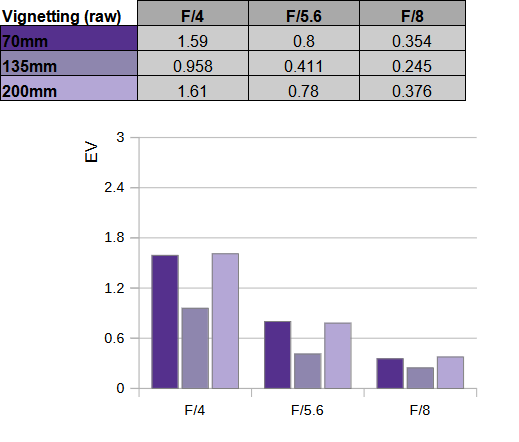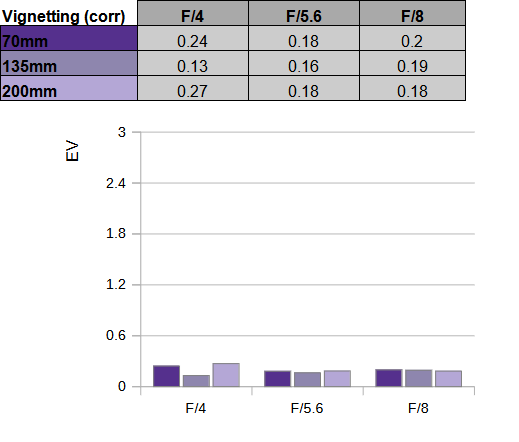|
Sony FE 70-200mm f/4 G OSS macro II - Review / Test Report |
|
Lens Reviews -
Sony Alpha (Full Format)
|
Review by Klaus Schroiff, published October 2023

Introduction
Time flies also in the mirrorless camera world. Some of the lenses released early in this era are getting a little long in the tooth - like the Sony FE 70-200mm f/4 G OSS, which was released back in 2014.
It's a fine lens also used by yours truly for a while. However, just like moths longing for the sun, we get excited when new stuff is coming around - in this case, the Sony FE 70-200mm f/4 G OSS macro II.
While the name may imply a mild evolution, it is actually a very different lens compared to its predecessor. And, as things go, the price tag has also increased to $1700USD or 2000EUR. That's quite a toad that you have to swallow for an f/4 zoom lens.
 Like it or not, it has an extending zoom design now. This has its pros and cons. The obvious advantage is that Sony managed to shave off 2.5cm in length (15%), which may make a welcome difference in your camera bag. Conversely, it is actually longer when fully extended to 200mm. Interestingly, the weight has barely changed - it's still around the 800g mark. The extending zoom mechanism also makes it easier for dust to enter the inner chamber - it's basically an air pump, so let's hope that Sony got the dust- and moisture sealing right with this lens. The build quality is superb, as you also expect from a G-class lens. The main body is made of metal, whereas the inner lens tube seems to be made of engineered plastics. There's no wobbling whatsoever, and the control rings operate smoothly. The lens has no less than 6(!) switches and 3 buttons. A transport lock, the usual AF-MF switch, a focus limiter, a DMF (direct-manual-focus) switch, an IS (Steady-Stop) control switch and an IS on/off switch. Plus, 3 focus lock buttons. A petal-shaped lens hood is provided. The supplied tripod mount is detachable.
Like it or not, it has an extending zoom design now. This has its pros and cons. The obvious advantage is that Sony managed to shave off 2.5cm in length (15%), which may make a welcome difference in your camera bag. Conversely, it is actually longer when fully extended to 200mm. Interestingly, the weight has barely changed - it's still around the 800g mark. The extending zoom mechanism also makes it easier for dust to enter the inner chamber - it's basically an air pump, so let's hope that Sony got the dust- and moisture sealing right with this lens. The build quality is superb, as you also expect from a G-class lens. The main body is made of metal, whereas the inner lens tube seems to be made of engineered plastics. There's no wobbling whatsoever, and the control rings operate smoothly. The lens has no less than 6(!) switches and 3 buttons. A transport lock, the usual AF-MF switch, a focus limiter, a DMF (direct-manual-focus) switch, an IS (Steady-Stop) control switch and an IS on/off switch. Plus, 3 focus lock buttons. A petal-shaped lens hood is provided. The supplied tripod mount is detachable.
 The other major change is the macro capability. The Sony FE 70-200mm f/4 G OSS macro II can focus down to just 26mm at 70mm and 42cm at 200mm. This translates to a max object magnification of 1:2 compared to the 1:7.7 on its older cousin.
This should be enough, at least for casual macro photography, and the long working distance is certainly a bonus here. Videographers will surely appreciate the new breathing compensation while focusing.
Sony incorporated 4 no less XD AF motors into the design. This results in quick and noiseless AF actions - also dependent on the used camera, of course. Manual focusing works "by wire", as usual.
The image stabilizer (OSS - optical steady shot) syncs with the in-camera image stabilizer. Sony doesn't provide any details regarding its efficiency. It should be around the 4 f-stop mark in real life, depending on your coffee intake. Last but not least, the lens is compatible with Sony's 1.4x and 2x converters.
The other major change is the macro capability. The Sony FE 70-200mm f/4 G OSS macro II can focus down to just 26mm at 70mm and 42cm at 200mm. This translates to a max object magnification of 1:2 compared to the 1:7.7 on its older cousin.
This should be enough, at least for casual macro photography, and the long working distance is certainly a bonus here. Videographers will surely appreciate the new breathing compensation while focusing.
Sony incorporated 4 no less XD AF motors into the design. This results in quick and noiseless AF actions - also dependent on the used camera, of course. Manual focusing works "by wire", as usual.
The image stabilizer (OSS - optical steady shot) syncs with the in-camera image stabilizer. Sony doesn't provide any details regarding its efficiency. It should be around the 4 f-stop mark in real life, depending on your coffee intake. Last but not least, the lens is compatible with Sony's 1.4x and 2x converters.
| Specifications |
|---|
| Optical construction | 19 elements in 13 groups (1x advanced aspherical, 1x aspherical, 1x Super ED, 3x ED elements) |
| Number of aperture blades | 9 (rounded) |
| min. focus distance | 0.26-0.42 (max. object magnification 1:2) |
| Dimensions | 82.2x149.0mm |
| Weight | 794g |
| Filter size | 67mm |
| Hood | petal-shaped, bayonet mount, supplied |
| Other features | dust & moisture-resistant, detachable tripod ring, breathing compensation, compatible with TCs, front fluorine coating |
Distortion
The Sony FE 70-200mm f/4 G OSS macro II produces relatively pronounced distortions in RAW images without being extreme. At 70mm, RAW images show a mild pincushion distortion increasing to high levels in the medium to upper range.
With activated image auto-correction, the distortions are almost perfectly corrected, as you can see below.
Vignetting
The RAW vignetting is slightly higher than average for a 70-200mm tele zoom lens. At maximum aperture and the extreme ends, the light falloff is visible at 1.6EV (f-stops). Stopping down by one f-stop reduces the issue substantially, and it's basically gone at f/11.
 With activated image auto-correction, you won't notice a significant vignetting anymore.
With activated image auto-correction, you won't notice a significant vignetting anymore.

MTF (resolution)
The Sony FE Sony FE 70-200mm f/4 G OSS macro II produced quite impressive resolution figures in our MTF lab. The center quality is excellent throughout the zoom range from f/4 to f/8. This also applies to the broader center zone at 70mm and 135mm, but there's a drop at 200mm down to very good results. The outer image field is generally good to very good at 70mm and 200mm, with a slightly higher peak quality in the middle of the zoom range. Diffraction has an impact from f/11. As usual, you shouldn't stop down beyond if feasible.
The centering quality of the tested sample was good. Field curvature is low.
Please note that the MTF results are not directly comparable across the different systems!
Below is a simplified summary of the formal findings. The chart shows line widths per picture height (LW/PH), which can be taken as a measure of sharpness.
If you want to know more about the MTF50 figures you may check out the corresponding Imatest Explanations

Chromatic Aberrations (CAs)
Lateral CAs (color shadows at the image borders) are well controlled at f/4 but increase slightly at the extreme ends of the zoom range when stopping down. An average CA pixel size of 1.7px at 70mm f/11 is a bit on the high side. That being said, lateral CAs are fully auto-corrected, so it's not a big deal.

Bokeh
Given its rather moderate max aperture of f/4, the Sony lens isn't a bokeh monster. Even so, it is an important criterion with all telephoto lenses, so let's see ...
It's a bit hard to see in the cropped images below, but the inner zone of an out-of-focus highlight has a slight onion-like sub-structure. There's also a bit of outlining that gets emphasized when stopping down.
 The shape of the highlights tends to deteriorate towards the image borders - this is due to mechanical vignetting. However, this happens quite "late" in the image corners. Stopping down by 1 f-stop corrects most of the issue already.
The general rendering in the focus transition zones is smooth both in the background (shown to the left below) and in the foreground (to the right).
The shape of the highlights tends to deteriorate towards the image borders - this is due to mechanical vignetting. However, this happens quite "late" in the image corners. Stopping down by 1 f-stop corrects most of the issue already.
The general rendering in the focus transition zones is smooth both in the background (shown to the left below) and in the foreground (to the right).

Bokeh Fringing / LoCA
Boheh fringing/LoCA is an axial color fringing effect with purplish halos in front of the focus point and greenish beyond.
The Sony lens produces just a tad of fringing at f/4, and it's basically gone from f/5.6.
You may also observe the crystal clear rendering in this close-focus scenario.
Sample Images
Click on an image to download the full-size variant.
 |
| Make | SONY |
| Model | ILCE-7RM5 |
| ISO Speed | 100 |
| Focal Length | 200.0mm |
| Aperture: | f/4.0 |
| Exposure | 1/640s |
 |
| Make | SONY |
| Model | ILCE-7RM5 |
| ISO Speed | 100 |
| Focal Length | 174.0mm |
| Aperture: | f/4.0 |
| Exposure | 1/800s |
 |
| Make | SONY |
| Model | ILCE-7RM5 |
| ISO Speed | 100 |
| Focal Length | 70.0mm |
| Aperture: | f/5.6 |
| Exposure | 1/640s |
 |
| Make | SONY |
| Model | ILCE-7RM5 |
| ISO Speed | 100 |
| Focal Length | 200.0mm |
| Aperture: | f/4.0 |
| Exposure | 1/320s |
 |
| Make | SONY |
| Model | ILCE-7RM5 |
| ISO Speed | 100 |
| Focal Length | 70.0mm |
| Aperture: | f/4.0 |
| Exposure | 1/1250s |
 |
| Make | SONY |
| Model | ILCE-7RM5 |
| ISO Speed | 100 |
| Focal Length | 200.0mm |
| Aperture: | f/4.0 |
| Exposure | 1/320s |
 |
| Make | SONY |
| Model | ILCE-7RM5 |
| ISO Speed | 100 |
| Focal Length | 94.0mm |
| Aperture: | f/5.6 |
| Exposure | 1/5000s |
 |
| Make | SONY |
| Model | ILCE-7RM5 |
| ISO Speed | 400 |
| Focal Length | 200.0mm |
| Aperture: | f/4.0 |
| Exposure | 1/250s |
 |
| Make | SONY |
| Model | ILCE-7RM5 |
| ISO Speed | 100 |
| Focal Length | 200.0mm |
| Aperture: | f/8.0 |
| Exposure | 1/800s |
 |
| Make | SONY |
| Model | ILCE-7RM5 |
| ISO Speed | 100 |
| Focal Length | 70.0mm |
| Aperture: | f/4.0 |
| Exposure | 1/1000s |
 |
| Make | SONY |
| Model | ILCE-7RM5 |
| ISO Speed | 100 |
| Focal Length | 70.0mm |
| Aperture: | f/4.0 |
| Exposure | 1/1600s |
 |
| Make | SONY |
| Model | ILCE-7RM5 |
| ISO Speed | 100 |
| Focal Length | 70.0mm |
| Aperture: | f/8.0 |
| Exposure | 1/160s |
 |
| Make | SONY |
| Model | ILCE-7RM5 |
| ISO Speed | 400 |
| Focal Length | 200.0mm |
| Aperture: | f/8.0 |
| Exposure | 1/500s |
 |
| Make | SONY |
| Model | ILCE-7RM5 |
| ISO Speed | 400 |
| Focal Length | 200.0mm |
| Aperture: | f/8.0 |
| Exposure | 1/320s |
Competition
The 70-200mm class is popular, and there are a number of alternatives to the Sony FE 70-200mm f/4 G OSS macro II (shown to the far left).
Depending on when you read this article, you may still get the older Sony FE 70-200mm f/4 G OSS (2nd left) in shops out there.
It's just marginally worse optically, so if you can get it with a good discount, it remains a quality option. Next in line is Sony's FE 70-200mm f/2.8 GM OSS II. Of course, it's more expensive, but the extra stop of speed is attractive.
Surprisingly, it's not all that much heavier at just 1045g. A more budget-friendly option is the Tamron 70-180mm f/2.8 Di III VXD (to the right) and its successor, the Tamron 70-180mm f/2.8 Di III VXD VC G2 (not shown).
You may lose 20mm at the long end, but for an f/2.8, it's DARN small and optically very decent as well. At least the G1 is a bit plasticy, though. We still have to get our hands on the G2.
And, finally, Sigma also just released its own interpretation of the 70-200mm f/2.8 topic - announced but not yet released at the time of this writing.
 Image courtesy of camerasize.com
Image courtesy of camerasize.com
Verdict
The Sony FE 70-200mm f/4 G OSS macro II is a high-performance lens with an interesting form factor. Optically, it isn't flawless - no lens is - but with a bit of digital trickery, the results are great.
In terms of resolution, it is up there with the best in class. The center quality is excellent throughout the zoom range at relevant aperture settings. The outer image field is good to very good. The contrast level is also extremely high for a zoom lens. Image distortions are fairly pronounced in RAW images, with some pincushion distortion towards the long end. Auto-correction handles this nicely. The RAW vignetting is slightly higher than average for a lens in this class.
The same goes for lateral at 70mm - but, once again, this isn't really relevant with auto-correction. The quality of the bokeh is good, but not on prime lens level. Out-of-focus highlights show a subtle onion ring substructure and a bit of outlining. The rendering of the general out-of-focus blur is quite nice, and there's also minimal bokeh fringing (LoCA).
The build quality is excellent, although it's debatable whether the switch to an extending zoom design is a good thing. However, as a result, it is one of the shortest tele-zoom lenses around. Needless to say, the lens also features a dust- and moisture-resistant design. The control rings turn smoothly, and there are heaps of switches for customization. A dedicated aperture ring is - surprisingly - missing.
Improvements compared to its predecessor include a faster AF motor, better image stabilization (including synced with the camera IS), and focus breathing compensation on camera bodies where this is supported.
The most important upgrade is its macro photography capability. It's not just by name like on many other "macro" zoom lenses, but the image quality remains also impressive.
Macro enthusiasts may still prefer a "true" macro lens because the Sony lens ends at 1:2 object magnification.
Overall, it's an attractive package with evolutionary progress in image quality and revolutionized macro capability ... but it's also extensive for what it is. Still, highly recommended!
Mechanical Quality:
★★★★★
What does this mean ?
|
|